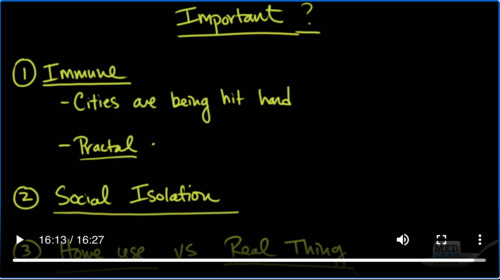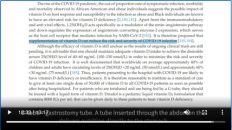What is %22Forest Bathing%22 & Can It Boost Immunity Against Viruses? (Lecture 56)
Welcome to another medcram covid-19 update. Total confirm now officially over 2 million.
In the United States, we have been seeing a decrease in the daily deaths and then there was the spike yesterday.
It’s unclear if it was related to how New York City death toll was being counted after these 3700 cases were added to the list. As it says here previously the city had not counted people who died at home without getting tested for the coronavirus. And so now they are including that in the death toll and there’s probably more according to officials there in New York. Overall, though daily new cases seem to be plateauing more time we’ll tell.
So I want to talk a little bit more about natural killer cells. As we’ve mentioned before these cells are part of the innate immune system. And they go around and gobble things up and present them to the adaptive immune system cells like T cells Etc. But they have things inside of them enzymes like granulysin, perforin, granzyme A and B(GrA/B).
And these are all part of the process of destroying cancer cells, but also viruses that infect the body. So I also want to cover some evidence and some research that indicates how we can increase these things in our body. We’ve already talked about the effect of temperature on the body and how it increases natural killer cells. We want to look at something different this time.
We’re going to go on a little field trip and we’re going to learn something along the way I hope.
So in case you didn’t know if you walk through a forest that’s known as forest bathing. And this is a really interesting paper it was put out in 2007 as a joint effort between Nippon Medical School in Tokyo and Stanford University School of Medicine in California. So what they decided to do was to take 12 subjects. In this case all of them were men and to have them spend three days and two nights in a forest.
Now these subjects were employees at large corporations in downtown Tokyo. And they drew blood three days prior to this at eight o’clock in the morning and then they drove quite a long distance to a forest. And on Day No.1 they traveled and in the afternoon they took a two-hour walk through a forest 2.5 kilometers. And they made sure that they weren’t doing any more exercise than they normally do in a regular work day. Then they spent the night at a residence or a motel in the forest. The next morning they got up and they drew blood again at eight o’clock in the morning. So they could compare it they wouldn’t have circadian issues. And then again for another 2 hours they went on a hike 2.5 kilometers in the forest. In the afternoon took another two-hour hike 2.5 kilometers, not too long. And they spent another night in the same Hotel got up the next morning. This would be now Day No. 3 and they drew blood again at 8 a.m. and then they went home.
Now even though they took blood here on the second day, this was really after one day of completion. So this is going to be known as blood on Day No.1 and this is going to be known as blood after Day No.2. So we’ll look at the results for those. So what were they looking for on the blood tests? Well, they looked at the leukocytes or the white blood cells. They also looked at those things that we talked about. They looked at granulysin, perforin and they looked at granzyme A and B.
Now, let’s see what they found.
As you can see in this graph, on the Before, Day 1 and Day 2, they were able to see natural killer cells per microliter when up statistically significantly on Day 1 and Day 2 relative to Before. And on Day 2 relative to Day 1, you can see here that the number of cells and the percent of cells also went up and that the natural killer cell activity also went up.
Now, what about those blood tests: Granulysin, Perforin, Granzyme A, Granzyme B? You can see that there was an increase in all of these substances from Zero to Day 1 and from Day 1 to Day 2.This graph over here shows exactly the same thing except on a proportion basis.
So why did this happen and why did they even think anything would happen in the first place?
Well, it seems as though the author’s had a hunch because what they refer to here at the end of the paper are something called fighting sides. These are aromatic compounds that are put off by trees and they are well known compounds such as alpha-pinene, beta pinene and isoprene. And they had studied this before and shown that in a test tube these compounds could enhance human natural killer cell activity and increased expression of intracellular cytolytic molecules such as perforin, GrA and GRN. Course that was in vitro. That suggested that on this trip fight on sides may partially contribute to the enhanced natural killer activity during the forest bathing trip. They finally conclude that taken together these findings indicate that Forest Bathing can increase human natural killer activity and that this effect is at least partially mediated by the induction of intracellular perforin, GrA and GrB and GRN and increase the number of natural killer cells.
But there’s still a lot of questions there. Maybe the effect was because they were no longer at their job or they were feeling more relaxed. So they did another study.
Same group published a paper titled visiting a forest but not a city increases human natural killer activity and expression of anti-cancer proteins.
So here is what they did. They divided it into two groups. The top group went to a forest and the bottom group went to a city not Tokyo because they’re from Tokyo. In fact both the forest and the city were about the same distance. Three days prior to the experiment, they took urine and blood samples. And then what they did is something very similar to what their first experiment was on the first day they arrived they did a two-hour trip. But in the forest they went on an ninth path 2.5 kilometers. In the city they also went for about 2.5 kilometers and they did the same thing on the second day in the morning and in the afternoon same with the city group in the morning and in the afternoon. Course in the morning again, they took a urine and blood samples urine and blood samples. And then finally on the third day they did exactly the same thing that they did in the first study 2.5 km/2h and 2.5 km/2h. And then both groups went home.
What they also did was they measured it again 7 days later in both groups and then 30 days later in both groups. And there was one of the thing that they measured find insides both of those aromatic compounds that are secreted by trees: the alpha-pinene and beta pinene and isoprene and the list goes on and on. Well, they measured it in the forest and also in the city. Let’s see what they found.
Here’s a list in terms of nanograms per cubic meter. And you can see here the forest bathing trip was just completely filled of these find insides:Tricyclene, Alpha-pinene, Camphene, Beta pinene, etc. etc. Whereas in the city visits you can see that for the most part there was none that was detected.
Okay, let’s look at the forest bathers first. Here we have before they went to the forest. Here we have at the end of Day 1. Here we have at the end of Day 2. And you can see both statistical significant increase in natural killer cell activity. And notice that even though they went back to their homes and Tokyo, seven days later there was still a statistical significant increase. It wasn’t until even 30 days later there was a mild increase that was statistically significant.
Let’s go over to those that went to the city. Here it is Before and then on Day 1 in the city staying at a very similar hotel and day 2 in the city staying at a very similar hotel. And so we can see here that the increase in Day 1 for the city here in Black was very minimal. Whereas for the forest the increase rate of natural killer cell activity with significantly elevated much more so than those for the colleagues that were in the city.
So that was activity. Let’s look at cells themselves natural killer cells again. For those that went to the forest significant increase in the cell count and then again at day 2 holding steady even 7 days after the initial exposure to the forest and then even at 30 days. Whereas here in the tourists to the city, there was really no increased that was statistically significant. And again, we see that the forest tourists had it much higher increase in natural killer cells than the city tourists.
Okay, what about those enzymes inside the natural killer cells we can see here again. Before Baseline we see it increase a Day 1, Day 2, holding steady at Day 7 and even elevated at Day 30. And we see that across the board for all of these enzymes. When we look here at those that went into the city, no statistical significant increase. They did also measure T cells notice that T cells really didn’t change in either of the camps: the city tourists or the forest tourists.
Now we did say that they had measured urine and what they were looking for their in the urine was urine adrenaline. And that’s important because adrenaline in general or a stress hormone is going to reduce the number of natural killer cells based on previous research. And so here in our forest tourists, we see that the Baseline adrenaline in these gentlemen that worked in Tokyo went down significantly by Day 1. And then by Day 2, there was a statistical significant difference between Day 2 and the Baseline. We did not see that here in those that were City tourists. So all of this led them to conclude that in summary a forest bathing trip can increase human natural killer activity, the number of natural killer cells and the expression of intracellular perforin, GrA/B and GRN. Forest bathing may contribute to decrease stress and improved immunity and fight on sides from trees may partially contribute to this effect.
So I’m sure you’re saying at this point like I am how do we really know that these essential oils from the trees are actually having this effect and it’s not something else. Well, they did a third experiment.
That’s right. A third study titled effect of fight inside from trees on human natural killer cell function.
Okay. So this is what they did. They took 12 subjects from a medical school in Tokyo and they had them sleep overnight in Tokyo in an urban hotel. But when they went to bed at 7 p.m, they had already been defusing the stem oil of hinoki cyprus which is this thing right here. They went to sleep at 11 p.m. And they did it each night in the day. They did their work as they normally do so they didn’t take them out of the city. These are medical students so they weren’t going to get out of nothing, right? And they took measurements of the hinoki Cypress stem well and other fight insides in the hotel room itself. So, let’s see what happened.
So they check for Alpha Pines and sure enough on Day 1,2 and 3 and the mean there was a consistent amount of this oil this aromatic compound that was circulating in the hotel room that they slept in.
Here we’re looking at the number of natural killer cells activity and the percentage of natural killer cells before and after they slept. And you can see there was a statistically significant increase in both and what about those enzymes statistical significant increase in all of those before and after.
What about urinary adrenaline? If you notice here this was not a statistical significant decrease in urine adrenaline. Remember these students were still in the city. They were just sleeping in the hotel room. They had not gone out to the forest. And if you notice here, their Baseline was just around 5 and it dropped to just around 4 and that was a non significant p-value.
Now if we go back to that second study notice that the Baseline adrenaline in the urine was around 5 so similar and that by Day 2 this was already below 3 and statistically significant. So even though we’re comparing apples to oranges, it seems as though the urinary adrenaline dropped more when they actually went to the forest than when they just stayed at the hotel in the city. What they did show though is that short-term exposure to a fight on side was able to increase a surrogate for natural innate immunity which is natural killer cells both in terms of percent and also an absolute number. But they also say that it’s necessary to conduct epidemiological studies or prospective studies in a population exposed to phytoncide in daily life to confirm it’s beneficial effect on human immune function in the future. So in summary, phytoncides from the tree can increase natural killer activity, the percentage of natural killer cells and the expression of intracellular perforin, GrA/B and GRN. Phytoncides enforced are may partially contribute to the increased natural killer activity in subjects visiting a forest.
So, why did I find this interesting? Well, the first thing of course is it’s about the immune system. Is it possible that we are leaving our city dwellers at a disadvantage because of this reduction in their natural killer cell activity. We do notice that cities are being hit particularly hard but that could be for other reasons because of the fact that people in cities are very close to each other. But one has to wonder then there’s the practical aspect of it. I mean according to that second study you only need to do it maybe once every seven days to get a benefit. Is there some prescription perhaps taking a rest once a week to go out to the forest and maybe spend some time to get the benefit of that. That might be interesting. The other aspect about this that is interesting is the social isolation that of course many of us are in at this point. Does this allow us to go out into the forest to get a benefit from this? Does our social isolation policy make something like this more difficult and maybe putting us at a disadvantage? It’s hard to say.
And how I see that third study is that there’s some way of reproducing the effect of going out into the forest by vaporizing essential oils, for instance the hinoki Cypress in this case. But do we really think it’s only the hinoki Cypress that does this or are there other things out there in the forest that may be contributing to it. We did notice that there wasn’t a precipitous drop in urinary adrenaline that we saw in that second case.
So do these three studies change anything for you? Let me know in the comments section below and I’ll put the links to these studies in the description below. Thanks for joining us.





Add comment